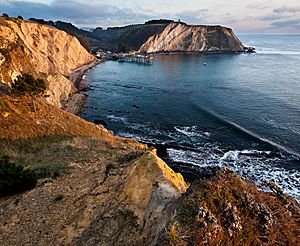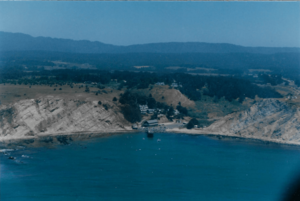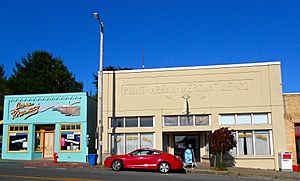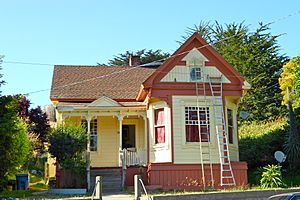Point Arena, California facts for kids
Quick facts for kids
Point Arena
|
|
|---|---|

Point Arena and its lighthouse
|
|

Location in Mendocino County and California
|
|
| Country | |
| State | |
| County | Mendocino |
| Incorporated | July 11, 1908 |
| Area | |
| • Total | 1.36 sq mi (3.5 km2) |
| • Land | 1.36 sq mi (3.5 km2) |
| • Water | 0.00 sq mi (0 km2) 0% |
| Elevation | 118 ft (36 m) |
| Population
(2020)
|
|
| • Total | 460 |
| • Density | 337.0/sq mi (130.1/km2) |
| Time zone | UTC-8 (PST) |
| • Summer (DST) | UTC-7 (PDT) |
| ZIP code |
95468
|
| Area code(s) | 707 |
| FIPS code | 06-57876 |
| GNIS feature ID | 1659411 |
Point Arena is a small city on the coast of California. It is located in Mendocino County, about 32 miles (51 km) west of Hopland. The city sits at an elevation of 118 feet (36 meters) above sea level. In 2020, about 460 people lived there, making it one of California's smallest cities.
Point Arena's main street is part of State Route 1, a famous road that runs along California's coast. The city is known for its beautiful coastal views and hiking trails. You can find these trails near the Point Arena City Hall. The area is also close to the lands of the Manchester Band of Pomo Indians of the Manchester Rancheria. It is also next to the Point Arena-Stornetta Public Lands National Monument. At Arena Cove Historic District and its pier, you can see huge ocean bluffs. These bluffs show the powerful way tectonic plates meet.
Contents
History of Point Arena
The first European to write about Point Arena was Bartolomé Ferrer in 1543. He was a Spaniard and called it Cabo de Fortunas, which means "cape of fortunes." In 1775, Lieutenant Juan Francisco de la Bodega y Quadra renamed the cape. He was part of a Spanish expedition and called it Punta Delgado, meaning "narrow point." Later, the point and the small town nearby were called Barra de Arena (sandbar). Finally, they became known as Punta Arena, which means "sand point."
The post office in Punta Arena opened in 1858. It was renamed Point Arena in 1889. The first store in Point Arena opened in 1859. The city officially became a city in 1908.
In 1886, an 11-year-old girl named Nellie Welch became the main operator of the telegraph office in Point Arena. She was in charge of everything. Companies like Western Union often hired women because they could pay them less than men.
The Point Arena Cable Station is in nearby Manchester. AT&T Corporation built it in 1956. This station is where several undersea cables come ashore. These cables connect to places like Hawaii, Canada, and even Japan. In 2002, AT&T needed a permit to connect a new cable. This was because the construction might harm the habitat of the endangered Point Arena mountain beaver.
Geography of Point Arena
Point Arena is located in the southwestern part of Mendocino County. Its ZIP Code is 95468. The city covers about 1.4 square miles (3.6 square kilometers) of land. There is no water area within the city limits.
The city is built around Arena Cove, which is a small natural harbor. The actual Point Arena is a narrow piece of land that sticks out into the Pacific Ocean. It is about 1.5 miles (2.4 km) south of the city. This is where the Point Arena Light stands. At 115 feet (35 meters), it is the tallest lighthouse on the west coast of the United States. The lighthouse is the closest place on the mainland (not including Alaska) to Honolulu, Hawaii. It is about 2,353 miles (3,787 km) away.
You can reach Point Arena by California State Route 1. It is 5 miles (8 km) south of Manchester. It is also 10 miles (16 km) north of Anchor Bay. To the east, Boonville is 29 miles (47 km) away. Ukiah, the county seat of Mendocino, is 50 miles (80 km) to the east.
Climate in Point Arena
Point Arena has cool, wet winters. Its summers are mild and fairly dry. This type of weather is called a cool-summer Mediterranean climate. In January, the average high temperature is 56.4°F (13.6°C). The average low is 40.2°F (4.6°C). In July, the average high is 65.2°F (18.4°C). The average low is 49.9°F (9.9°C).
It rarely gets very hot in Point Arena. There are only about 0.3 days a year when the temperature reaches 90°F (32°C) or higher. It also doesn't get very cold often. There are about 14.1 days a year when the temperature drops to 32°F (0°C) or lower. The highest temperature ever recorded was 95°F (35°C). This happened on August 12, 1947, and September 28, 1966. The lowest temperature ever recorded was 22°F (-6°C) on January 21, 1962.
Point Arena gets about 41.28 inches (1,049 mm) of rain each year. On average, there are 83 days with measurable rain. The wettest year was 1983, with 83.34 inches (2,117 mm) of rain. The driest year was 1976, with only 21.23 inches (539 mm). The most rain in one month was 21.99 inches (559 mm). The most rain in 24 hours was 5.09 inches (129 mm) on January 24, 1944.
| Climate data for Point Arena | |||||||||||||
|---|---|---|---|---|---|---|---|---|---|---|---|---|---|
| Month | Jan | Feb | Mar | Apr | May | Jun | Jul | Aug | Sep | Oct | Nov | Dec | Year |
| Record high °F (°C) | 76 (24) |
80 (27) |
79 (26) |
83 (28) |
83 (28) |
85 (29) |
89 (32) |
95 (35) |
90 (32) |
92 (33) |
79 (26) |
74 (23) |
95 (35) |
| Mean daily maximum °F (°C) | 56.4 (13.6) |
57.2 (14.0) |
57.8 (14.3) |
59.1 (15.1) |
61.1 (16.2) |
63.0 (17.2) |
65.2 (18.4) |
65.7 (18.7) |
66.7 (19.3) |
64.9 (18.3) |
60.7 (15.9) |
57.2 (14.0) |
61.3 (16.3) |
| Mean daily minimum °F (°C) | 40.2 (4.6) |
42.0 (5.6) |
42.4 (5.8) |
43.1 (6.2) |
46.0 (7.8) |
48.6 (9.2) |
49.9 (9.9) |
50.5 (10.3) |
49.8 (9.9) |
47.2 (8.4) |
43.3 (6.3) |
41.4 (5.2) |
45.4 (7.4) |
| Record low °F (°C) | 22 (−6) |
25 (−4) |
26 (−3) |
28 (−2) |
30 (−1) |
34 (1) |
38 (3) |
38 (3) |
33 (1) |
28 (−2) |
25 (−4) |
24 (−4) |
22 (−6) |
| Average precipitation inches (mm) | 7.73 (196) |
6.89 (175) |
5.55 (141) |
2.94 (75) |
0.93 (24) |
0.29 (7.4) |
0.12 (3.0) |
0.3 (7.6) |
0.72 (18) |
2.91 (74) |
5.65 (144) |
7.26 (184) |
41.28 (1,049) |
| Average precipitation days | 12 | 12 | 12 | 7 | 5 | 2 | 1 | 1 | 3 | 6 | 10 | 12 | 83 |
Geology of Point Arena

The famous San Andreas Fault goes into the ocean near Alder Creek. This is about 6 miles (10 km) north of Point Arena. The huge 1906 San Francisco earthquake was strongly felt in Point Arena. It badly damaged the Point Arena Lighthouse, which then had to be torn down and rebuilt.
Wildlife and Nature in Point Arena
The Point Arena area is home to many different plants and animals. It's a special place where some animal species reach their northern or southern limits. For example, the California giant salamander lives south of Point Arena. The Pacific giant salamander lives to the north.
Point Arena is also the home of a special animal called the Point Arena mountain beaver. Its scientific name is Aplodontia rufa nigra. This animal is considered endangered by the United States government. The State of California also sees it as a species that needs special attention. This type of mountain beaver only lives in a small area of about 24 square miles (62 square kilometers) around Point Arena. The biggest danger to these mountain beavers is losing their natural homes. They were officially listed as an endangered species on December 12, 1991. Many local stories are told about this mysterious creature.
The Point Arena State Marine Reserve & Point Arena State Marine Conservation Area are two special underwater areas. They are located off the coast of Point Arena. Like underwater parks, these areas help protect ocean wildlife and marine ecosystems. Other similar areas nearby include Sea Lion Cove State Marine Conservation Area and Saunders Reef State Marine Conservation Area to the south.
Population of Point Arena
| Historical population | |||
|---|---|---|---|
| Census | Pop. | %± | |
| 1880 | 198 | — | |
| 1890 | 709 | 258.1% | |
| 1910 | 497 | — | |
| 1920 | 394 | −20.7% | |
| 1930 | 385 | −2.3% | |
| 1940 | 374 | −2.9% | |
| 1950 | 372 | −0.5% | |
| 1960 | 596 | 60.2% | |
| 1970 | 424 | −28.9% | |
| 1980 | 425 | 0.2% | |
| 1990 | 407 | −4.2% | |
| 2000 | 474 | 16.5% | |
| 2010 | 449 | −5.3% | |
| 2020 | 460 | 2.4% | |
| U.S. Decennial Census | |||
In 2010, the population of Point Arena was 449 people. Most residents (67.9%) were White. About 26.3% were from other races. People of Hispanic or Latino background made up 33.4% of the population.
The average age of people in Point Arena was 40 years old. About 24.9% of the population was under 18 years old.
Education in Point Arena
Point Arena has three high schools for students:
- Point Arena High School
- South Coast Continuation High School
- Pacific Community Charter High School
Students can take classes at both Point Arena High and the Charter High schools. This gives them many choices for their studies. These schools also welcome students from a wide area. They draw students from southern Mendocino and northern Sonoma counties.
See also
 In Spanish: Punta Arenas (California) para niños
In Spanish: Punta Arenas (California) para niños





